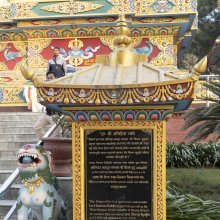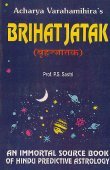Yasa, Yaśā, Yaśa, Yasha, Yāsa: 24 definitions
Introduction:
Yasa means something in Buddhism, Pali, Hinduism, Sanskrit, Jainism, Prakrit, Marathi, Hindi, biology. If you want to know the exact meaning, history, etymology or English translation of this term then check out the descriptions on this page. Add your comment or reference to a book if you want to contribute to this summary article.
The Sanskrit terms Yaśā and Yaśa can be transliterated into English as Yasa or Yasha, using the IAST transliteration scheme (?).
Alternative spellings of this word include Yash.
Images (photo gallery)
(+6 more images available)
In Hinduism
Shaktism (Shakta philosophy)
Source: Wisdom Library: ŚāktismYaśā (यशा, “beauty, glory”):—Name of one of the sixty-four mātṛs to be worshipped during Āvaraṇapūjā (“Worship of the Circuit of Goddesses”, or “Durgā’s Retinue”), according to the Durgāpūjātattva. They should be worshipped with either the five upācāras or perfume and flowers.
Her mantra is as follows:
ॐ यशायै नमः
oṃ yaśāyai namaḥ.
A similar mantra is mentioned by the same text, prefixed with ह्रीं (hrīṃ), to be worshipped at the goddess’s right.

Shakta (शाक्त, śākta) or Shaktism (śāktism) represents a tradition of Hinduism where the Goddess (Devi) is revered and worshipped. Shakta literature includes a range of scriptures, including various Agamas and Tantras, although its roots may be traced back to the Vedas.
Ayurveda (science of life)
Cikitsa (natural therapy and treatment for medical conditions)
Source: Wisdom Library: Ayurveda: Cikitsa
1) Yāsa (यास) is a Sanskrit word referring to the “camel thorn”, a species of plant from the Lythraceae family, and is used throughout Ayurvedic literature such as the Caraka-saṃhitā. It also known by the name Dhātakī or Madanīyahetu. The official botanical name of the plant is Alhagi maurorum. It is a deciduous Shrub growing to 2m in height. It is in flower in July. The flowers are hermaphrodite (have both male and female organs). It can also fix Nitrogen.
2) Yāsa (यास):—Another name for Dhanvayavāsa, a medicinal plant (Alhagi maurorum/camelorum) used in the treatment of fever (jvara), as described in the Jvaracikitsā (or “the treatment of fever”) which is part of the 7th-century Mādhavacikitsā, a Sanskrit classical work on Āyurveda.
Nighantu (Synonyms and Characteristics of Drugs and technical terms)
Source: WorldCat: Rāj nighaṇṭuYāsa (यास) is another name for Yavāsa, a medicinal plant identified with Alhagi pseudalhagi, synonym of Alhagi maurorum (“camelthorn”) from the Fabaceae or legume family of flowering plants, according to verse 4.44-46 of the 13th-century Raj Nighantu or Rājanighaṇṭu. The fourth chapter (śatāhvādi-varga) of this book enumerates eighty varieties of small plants (pṛthu-kṣupa). Together with the names Yāsa and Yavāsa, there are a total of twenty-two Sanskrit synonyms identified for this plant.
Unclassified Ayurveda definitions
Source: gurumukhi.ru: Ayurveda glossary of termsYaśa (यश):—[yaśaḥ] Success; Conducting to reputation: splendor, glory, fame, honour, respectability

Āyurveda (आयुर्वेद, ayurveda) is a branch of Indian science dealing with medicine, herbalism, taxology, anatomy, surgery, alchemy and related topics. Traditional practice of Āyurveda in ancient India dates back to at least the first millenium BC. Literature is commonly written in Sanskrit using various poetic metres.
Purana and Itihasa (epic history)
Source: Cologne Digital Sanskrit Dictionaries: The Purana Index1a) Yaśa (यश).—A son of Kīrti.*
- * Brahmāṇḍa-purāṇa II. 9. 62; Vāyu-purāṇa 10. 37.
1b) A Vaikuṇṭha god.*
- * Brahmāṇḍa-purāṇa II. 36. 57; Vāyu-purāṇa 62. 9.
1c) One of the twenty Sutapa gaṇas.*
- * Vāyu-purāṇa 100. 15; Brahmāṇḍa-purāṇa IV. 1. 15.

The Purana (पुराण, purāṇas) refers to Sanskrit literature preserving ancient India’s vast cultural history, including historical legends, religious ceremonies, various arts and sciences. The eighteen mahapuranas total over 400,000 shlokas (metrical couplets) and date to at least several centuries BCE.
Jyotisha (astronomy and astrology)
Source: academia.edu: Tithikarmaguṇa in GārgīyajyotiṣaYaśā (यशा) or Yaśatithi is the name of the twelfth of fifteen tithis (cycle of time) according to both the Gārgīyajyotiṣa and the Śārdūlakarṇāvadāna. The associated deity for Yaśā according to the Bṛhatsaṃhitā is Savitṛ. A tithi was defined as one thirtieth of a synodic month (c. 29.5 days), resulting in an average tithi being slightly less than a day.
Accordingly, “(33) The twelfth tithi is called Yamā. One should perform deeds which are firm and glorifying. One should undergo auspicious acts and applications of mantras. (34) One should prepare storehouses and bury treasures. One should not take a loan. The Sun is the deity on this tithi”.

Jyotisha (ज्योतिष, jyotiṣa or jyotish) refers to ‘astronomy’ or “Vedic astrology” and represents the fifth of the six Vedangas (additional sciences to be studied along with the Vedas). Jyotisha concerns itself with the study and prediction of the movements of celestial bodies, in order to calculate the auspicious time for rituals and ceremonies.
Chandas (prosody, study of Sanskrit metres)
Source: Shodhganga: a concise history of Sanskrit Chanda literatureYasa was the great-grand-father of Rājaśekhara alias Jayaśekhara, who describes himself as an Ārhata and a kavi in the last stanza of fifth chapter of Chandaśśekhara. Jayaśekhara was the son of Duddaka and Nāgadevī, grandson of Lāhata and great grandson of Yasa. He belonged to the Ṭhakkura family.

Chandas (छन्दस्) refers to Sanskrit prosody and represents one of the six Vedangas (auxiliary disciplines belonging to the study of the Vedas). The science of prosody (chandas-shastra) focusses on the study of the poetic meters such as the commonly known twenty-six metres mentioned by Pingalas.
In Buddhism
Theravada (major branch of Buddhism)
Source: Pali Kanon: Pali Proper Names1. Yasa Thera. He was the son of a very wealthy treasurer of Benares, and was brought up in great luxury, living in three mansions, according to the seasons and surrounded with all kinds of pleasures. Impelled by antecedent conditions, he saw one night the indecorum of his sleeping attendants, and, greatly distressed, put on his gold slippers and left the house and the town, non humans opening the gates for him. He took the direction of Isipatana, exclaiming: Alas! What distress! Alas! What danger! The Buddha saw him in the distance and called to him, Come Yasa, here is neither distress nor danger. Filled with joy, Yasa took off his slippers and sat beside the Buddha. The Buddha preached to him a graduated discourse, and when he had finished teaching the Truths, Yasa attained realization of the Dhamma. To Yasas father, too, who had come in search of his son, the Buddha preached the Doctrine, having first made Yasa invisible to him. (This is given as an example of the Buddhas iddhi power, Vsm.393). At the end of the sermon he acknowledged himself the Buddhas follower, (he thus became the first tevacika upasaka) and Yasa, who had been listening, became an arahant. When, therefore, Yasas presence became known to his father, who asked him to return to his grieving mother, the Buddha declared that household life had no attractions for Yasa and granted his request to be admitted to the Order. The next day, at the invitation of Yasas father, he went, accompanied by Yasa, to his house, and there, at the conclusion of the meal, he preached to Yasas mother and other members of the household, who all became his followers, thus becoming the first tevacika upasika. When Yasas intimate friends, Vimala, Subahu, Punnaji and Gavampati, heard of Yasas ordination they followed his example and joined the Order, attaining arahantship in due course, as did fifty others of Yasas former friends and acquaintances (Vin.i.15 20; DhA.i.72).
In the time of Sumedha Buddha, Yasa was a king of the Nagas and invited the Buddha and his monks to his abode, where he showed them great honour and hospitality. He then gave costly robes to the Buddha and to each monk a pair of valuable robes. In the time of Siddhattha Buddha he was a Treasurer, and offered the seven kinds of jewels at the Bodhi tree. In the time of Kassapa Buddha he was a monk. For eighteen thousand kappas he was a deva king and one thousand times he was king of men. Wherever he went he had a gold canopy, and in his last life over his funeral pyre was a gold canopy (ThagA.i.232f). He is evidently identical with Sabbadayaka of the Apadana (Ap.i.333f). A verse attributed to him is found in the Theragatha (vs.117).
Yasa is often quoted as one who enjoyed great luxury in his lay life (AA.ii.596).
The Dhammapada Commentary (DhA.i.82f ) states that, in a past life,
Theravāda is a major branch of Buddhism having the the Pali canon (tipitaka) as their canonical literature, which includes the vinaya-pitaka (monastic rules), the sutta-pitaka (Buddhist sermons) and the abhidhamma-pitaka (philosophy and psychology).
In Jainism
General definition (in Jainism)
Source: archive.org: Personal and geographical names in the Gupta inscriptions (jainism)Yāsa (यास) is a Prakrit ending for deriving proper personal names, mentioned as an example in the Aṅgavijjā chapter 26. This chapter includes general rules to follow when deriving proper names. The Aṅgavijjā (mentioning yāsa) is an ancient treatise from the 3rd century CE dealing with physiognomic readings, bodily gestures and predictions and was written by a Jain ascetic in 9000 Prakrit stanzas.

Jainism is an Indian religion of Dharma whose doctrine revolves around harmlessness (ahimsa) towards every living being. The two major branches (Digambara and Svetambara) of Jainism stimulate self-control (or, shramana, ‘self-reliance’) and spiritual development through a path of peace for the soul to progess to the ultimate goal.
Biology (plants and animals)
Source: Google Books: CRC World Dictionary (Regional names)1) Yasa in Central Africa is the name of a plant defined with Terminalia superba in various botanical sources. This page contains potential references in Ayurveda, modern medicine, and other folk traditions or local practices.
2) Yasa in India is also identified with Alhagi pseudalhagi It has the synonym Alhagi pseudalhagi (M. Bieb.) Desv. (etc.).
3) Yasa is also identified with Alhagi maurorum It has the synonym Alhagi camelorum DC. (etc.).
4) Yasa in Nigeria is also identified with Afzelia africana It has the synonym Pahudia africana Prain (etc.).
Example references for further research on medicinal uses or toxicity (see latin names for full list):
· The Languages of West Africa. (1911)
· Annals of the Missouri Botanical Garden (1994)
· Monographien afrikanischer Pflanzen-Familien und -Gattungen (1899)
· Terminalia superba: A Monograph. (1985)
· Pharmazie (2006)
· The Mende Language. (1908)
If you are looking for specific details regarding Yasa, for example side effects, health benefits, extract dosage, diet and recipes, pregnancy safety, chemical composition, have a look at these references.

This sections includes definitions from the five kingdoms of living things: Animals, Plants, Fungi, Protists and Monera. It will include both the official binomial nomenclature (scientific names usually in Latin) as well as regional spellings and variants.
Languages of India and abroad
Pali-English dictionary
Source: BuddhaSasana: Concise Pali-English Dictionaryyasa : (m.; nt.) (mano-group), fame; glory; success; retinue.

Pali is the language of the Tipiṭaka, which is the sacred canon of Theravāda Buddhism and contains much of the Buddha’s speech. Closeley related to Sanskrit, both languages are used interchangeably between religions.
Marathi-English dictionary
Source: DDSA: The Molesworth Marathi and English Dictionaryyaśa (यश).—m (S) Propitiousness or felicity of destiny; luckiness or fortunateness. 2 Success; happy result or issue. 3 Credit, honor, glory; esp. credit or praise viewed as involved in the acknowledgment by others of our good deeds towards them. 4 S Fame, renown, celebrity.
Source: DDSA: The Aryabhusan school dictionary, Marathi-Englishyaśa (यश).—m Luckiness. Success. Credit. Fame. yaśa lābhāsa yēṇēṃ Begin to reward the labours and cares, or realize the pros- pects and hopes of.
Marathi is an Indo-European language having over 70 million native speakers people in (predominantly) Maharashtra India. Marathi, like many other Indo-Aryan languages, evolved from early forms of Prakrit, which itself is a subset of Sanskrit, one of the most ancient languages of the world.
Sanskrit dictionary
Source: DDSA: The practical Sanskrit-English dictionaryYāsa (यास).—
1) Effort, endeavour.
2) Alhagi Maurorum (Mar. dhamāsā).
Derivable forms: yāsaḥ (यासः).
Source: Cologne Digital Sanskrit Dictionaries: Edgerton Buddhist Hybrid Sanskrit DictionaryYaśa (यश).—see Yaśas.
Source: Cologne Digital Sanskrit Dictionaries: Shabda-Sagara Sanskrit-English DictionaryYāsa (यास).—m.
(-saḥ) 1. A plant, (Hedysarum alhagi) “durālabhāyām”. 2. Effort. f.
(-sā) A sort of bird, the Salika. E. yas to endeavour, aff. ghañ .
Source: Cologne Digital Sanskrit Dictionaries: Cappeller Sanskrit-English DictionaryYāsa (यास).—[masculine] [Name] of a plant.
Source: Cologne Digital Sanskrit Dictionaries: Monier-Williams Sanskrit-English Dictionary1) Yaśa (यश):—a yaśaḥ etc. See below.
2) [from yaśas] b mfn. (ifc.) = yaśas (See ati-yaśa).
3) Yāsa (यास):—m. = yavāsa, Alhagi Maurorum, [cf. Lexicographers, esp. such as amarasiṃha, halāyudha, hemacandra, etc.] (-śarkarā f. = yavāsa-ś, [Caraka])
4) Yāsā (यासा):—[from yāsa] f. Turdus Salica, [cf. Lexicographers, esp. such as amarasiṃha, halāyudha, hemacandra, etc.]
Source: Cologne Digital Sanskrit Dictionaries: Yates Sanskrit-English DictionaryYāsa (यास):—(saḥ) 1. m. A plant (Hedysarum alhagi). f. (sā) A bird.
Source: DDSA: Paia-sadda-mahannavo; a comprehensive Prakrit Hindi dictionary (S)Yaśā (यशा) in the Sanskrit language is related to the Prakrit word: Jasā.
[Sanskrit to German]
Sanskrit, also spelled संस्कृतम् (saṃskṛtam), is an ancient language of India commonly seen as the grandmother of the Indo-European language family (even English!). Closely allied with Prakrit and Pali, Sanskrit is more exhaustive in both grammar and terms and has the most extensive collection of literature in the world, greatly surpassing its sister-languages Greek and Latin.
Hindi dictionary
Source: DDSA: A practical Hindi-English dictionaryYaśa (यश) [Also spelled yash]:—(nm) fame, reputation, renown, glory; —[kamānā] to earn name and fame; —[gānā] to sing the praises of; to eulogize, to extol; —[lūṭanā] to usurp fame, to acquire glory.
...
Kannada-English dictionary
Source: Alar: Kannada-English corpusYaśa (ಯಶ):—
1) [noun] fame; celebrity; renown.
2) [noun] accomplishment of an aim; favourable outcome; succes.
3) [noun] attainment of wealth, fame or position; success.
--- OR ---
Yasa (ಯಸ):—[noun] = ಯಶಸ್ಸು [yashassu].
--- OR ---
Yāsa (ಯಾಸ):—
1) [noun] a try; an effort.
2) [noun] the plant Alhagi maurorum of Papilionaceae family.
3) [noun] the annual herb Coriandrum sativum of Umbellifarae family; coriander.
4) [noun] its strong-smelling, seedlike fruit, used in flavouring food and liquors; coriander seed.
Kannada is a Dravidian language (as opposed to the Indo-European language family) mainly spoken in the southwestern region of India.
See also (Relevant definitions)
Starts with (+111): Yacacu, Yacacuvi, Yacakam, Yacakan, Yacaman, Yacanai, Yacanam, Yacotai, Yacotarakaviyam, Yacovati, Yasa Sutta, Yasadayaka, Yasagga, Yasai, Yasaigari, Yasaiusai, Yasaka, Yasakarana, Yasalabha, Yasalalaka.
Ends with (+582): Abhibhuyayasha, Abhinyasa, Abhiyasha, Abhyasa, Acikhyasa, Adhyasa, Adityayashas, Agniniryasa, Agniniryyasa, Ahamshreyasa, Aharvyasa, Ahiyasa, Aiyasha, Akashopanyasa, Aksharabhyasa, Aksharanyasa, Aksharavinyasa, Alpayasa, Amdakadharavinyasa, Amurtarayasa.
Full-text (+363): Yashas, Atiyasha, Yashahpataha, Yashahshesha, Dhanuryasa, Jasha, Dhanvayasa, Yasasa, Mahayashas, Yashaskama, Yashahsharira, Suyasha, Yashah, Yashahsheshibhuta, Anabhibhutayashas, Prayasa, Yashahkarna, Yashahprabha, Yashasya, Yashahprabhava.
Relevant text
Search found 96 books and stories containing Yasa, Yaśā, Yaśa, Yasha, Yāsa, Yāsā; (plurals include: Yasas, Yaśās, Yaśas, Yashas, Yāsas, Yāsās). You can also click to the full overview containing English textual excerpts. Below are direct links for the most relevant articles:
The Gospel of Buddha (by Paul Carus)
Rig Veda (translation and commentary) (by H. H. Wilson)
Garga Samhita (English) (by Danavir Goswami)
Verse 2.9.58 < [Chapter 9 - Brahmā’s Prayers]
Verse 1.4.17 < [Chapter 4 - Description of Questions About the Lord’s Appearance]
Verse 2.11.32 < [Chapter 11 - The Liberation of Dhenukāsura]
Sahitya-kaumudi by Baladeva Vidyabhushana (by Gaurapada Dāsa)
Text 10.126 < [Chapter 10 - Ornaments of Meaning]
Text 10.206 < [Chapter 10 - Ornaments of Meaning]
Text 10.18 < [Chapter 10 - Ornaments of Meaning]
Amaravati Art in the Context of Andhra Archaeology (by Sreyashi Ray chowdhuri)
The Conversion of Yaśa and his friends < [Chapter 3 - Amarāvatī and the Formative Stage of the Buddhist Art]
Vinaya Pitaka (3): Khandhaka (by I. B. Horner)
On the going forth of Yasa < [1. Going forth (Pabbajjā)]
First recitation section < [22. (Recitation with) Seven Hundred (Sattasata)]
Related products







